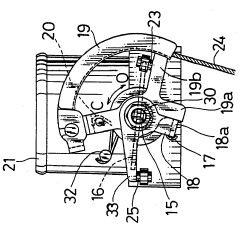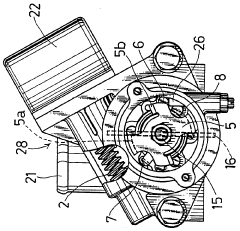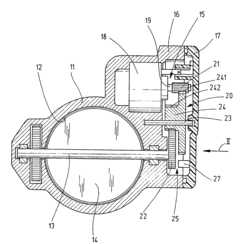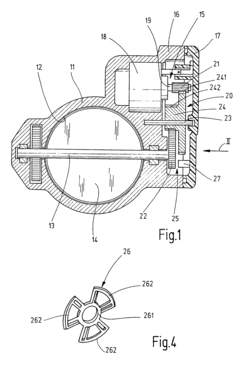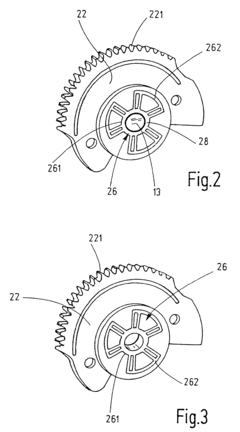Exploring Throttle Body Control in Robotics and Automation
JUL 18, 20259 MIN READ
Generate Your Research Report Instantly with AI Agent
Patsnap Eureka helps you evaluate technical feasibility & market potential.
Throttle Body Control Evolution and Objectives
Throttle body control has evolved significantly in the field of robotics and automation over the past few decades. Initially developed for automotive applications, this technology has found its way into various robotic systems and automated machinery. The primary objective of throttle body control in these domains is to regulate the flow of air or fluid, thereby controlling the speed and power output of actuators or engines.
The evolution of throttle body control in robotics and automation can be traced back to the early 1980s when electronic fuel injection systems began replacing carburetors in automobiles. This transition marked the beginning of more precise and efficient engine control. As robotics and automation technologies advanced, engineers recognized the potential of adapting throttle body control principles to enhance the performance and efficiency of various mechanical systems.
In the 1990s, the integration of throttle body control in industrial robots began to gain traction. This development aimed to improve the precision and responsiveness of robotic arms and manipulators, particularly in manufacturing and assembly processes. The ability to finely adjust the flow of hydraulic fluid or compressed air allowed for more accurate positioning and smoother movements of robotic components.
The early 2000s saw a significant leap in throttle body control technology with the introduction of drive-by-wire systems. This innovation eliminated the need for mechanical linkages between the throttle pedal and the engine, replacing them with electronic sensors and actuators. This concept was quickly adopted in advanced robotics, enabling more sophisticated control algorithms and improved overall system performance.
As we entered the 2010s, the focus shifted towards developing more intelligent and adaptive throttle body control systems. The integration of machine learning and artificial intelligence algorithms allowed for real-time optimization of throttle response based on various environmental and operational factors. This advancement has been particularly beneficial in autonomous robots and vehicles, where precise control over speed and power is crucial for navigation and task execution.
The current objectives of throttle body control in robotics and automation are multifaceted. One primary goal is to further enhance energy efficiency by optimizing the power output of actuators and engines. This is especially important in battery-powered robots and autonomous systems, where energy conservation directly impacts operational duration and overall performance.
Another key objective is to improve the responsiveness and precision of robotic systems across a wide range of applications. From industrial manufacturing to medical robotics, the ability to execute intricate movements with high accuracy is paramount. Advanced throttle body control systems play a crucial role in achieving this level of performance.
Looking ahead, the future objectives of throttle body control in robotics and automation include the development of more robust and adaptable systems capable of operating in diverse and challenging environments. This includes improving resistance to temperature fluctuations, vibrations, and other external factors that can affect throttle performance. Additionally, there is a growing emphasis on integrating throttle body control with other emerging technologies, such as IoT and edge computing, to create more interconnected and intelligent robotic ecosystems.
The evolution of throttle body control in robotics and automation can be traced back to the early 1980s when electronic fuel injection systems began replacing carburetors in automobiles. This transition marked the beginning of more precise and efficient engine control. As robotics and automation technologies advanced, engineers recognized the potential of adapting throttle body control principles to enhance the performance and efficiency of various mechanical systems.
In the 1990s, the integration of throttle body control in industrial robots began to gain traction. This development aimed to improve the precision and responsiveness of robotic arms and manipulators, particularly in manufacturing and assembly processes. The ability to finely adjust the flow of hydraulic fluid or compressed air allowed for more accurate positioning and smoother movements of robotic components.
The early 2000s saw a significant leap in throttle body control technology with the introduction of drive-by-wire systems. This innovation eliminated the need for mechanical linkages between the throttle pedal and the engine, replacing them with electronic sensors and actuators. This concept was quickly adopted in advanced robotics, enabling more sophisticated control algorithms and improved overall system performance.
As we entered the 2010s, the focus shifted towards developing more intelligent and adaptive throttle body control systems. The integration of machine learning and artificial intelligence algorithms allowed for real-time optimization of throttle response based on various environmental and operational factors. This advancement has been particularly beneficial in autonomous robots and vehicles, where precise control over speed and power is crucial for navigation and task execution.
The current objectives of throttle body control in robotics and automation are multifaceted. One primary goal is to further enhance energy efficiency by optimizing the power output of actuators and engines. This is especially important in battery-powered robots and autonomous systems, where energy conservation directly impacts operational duration and overall performance.
Another key objective is to improve the responsiveness and precision of robotic systems across a wide range of applications. From industrial manufacturing to medical robotics, the ability to execute intricate movements with high accuracy is paramount. Advanced throttle body control systems play a crucial role in achieving this level of performance.
Looking ahead, the future objectives of throttle body control in robotics and automation include the development of more robust and adaptable systems capable of operating in diverse and challenging environments. This includes improving resistance to temperature fluctuations, vibrations, and other external factors that can affect throttle performance. Additionally, there is a growing emphasis on integrating throttle body control with other emerging technologies, such as IoT and edge computing, to create more interconnected and intelligent robotic ecosystems.
Market Demand Analysis for Robotic Throttle Control
The market demand for robotic throttle control systems has been experiencing significant growth in recent years, driven by the increasing adoption of automation and robotics across various industries. This technology plays a crucial role in enhancing precision, efficiency, and safety in robotic applications, particularly in manufacturing, automotive, aerospace, and industrial sectors.
In the manufacturing industry, the demand for robotic throttle control is primarily fueled by the need for improved production efficiency and quality control. Manufacturers are increasingly integrating robotic systems with advanced throttle control mechanisms to achieve precise movements and force control in assembly lines, material handling, and packaging processes. This trend is expected to continue as more companies embrace Industry 4.0 principles and smart manufacturing concepts.
The automotive sector represents another significant market for robotic throttle control systems. As vehicle production becomes more automated, there is a growing need for precise control of robotic arms and actuators in tasks such as welding, painting, and component assembly. Additionally, the development of autonomous vehicles has created new opportunities for throttle control technologies in steering, braking, and acceleration systems.
In the aerospace industry, robotic throttle control is gaining traction in aircraft manufacturing and maintenance processes. The technology enables precise control of robotic systems used in tasks such as riveting, drilling, and inspection, contributing to improved quality and reduced production times. As the aerospace industry continues to focus on efficiency and cost reduction, the demand for advanced robotic control systems is expected to rise.
The industrial sector, including process industries and logistics, is also driving the market for robotic throttle control. Applications such as material handling, palletizing, and warehouse automation require precise control of robotic movements to ensure safety and efficiency. The growing trend towards warehouse automation and the adoption of collaborative robots (cobots) in industrial settings are further boosting the demand for advanced throttle control solutions.
Emerging technologies such as artificial intelligence and machine learning are expected to play a significant role in shaping the future of robotic throttle control. These technologies enable more adaptive and intelligent control systems, capable of real-time adjustments based on environmental factors and task requirements. This trend is likely to create new market opportunities and drive innovation in the field of robotic control.
Geographically, North America and Europe currently lead the market for robotic throttle control systems, owing to their advanced manufacturing sectors and high adoption rates of automation technologies. However, the Asia-Pacific region is expected to witness the fastest growth in the coming years, driven by rapid industrialization, increasing investments in automation, and the presence of major manufacturing hubs in countries like China, Japan, and South Korea.
In the manufacturing industry, the demand for robotic throttle control is primarily fueled by the need for improved production efficiency and quality control. Manufacturers are increasingly integrating robotic systems with advanced throttle control mechanisms to achieve precise movements and force control in assembly lines, material handling, and packaging processes. This trend is expected to continue as more companies embrace Industry 4.0 principles and smart manufacturing concepts.
The automotive sector represents another significant market for robotic throttle control systems. As vehicle production becomes more automated, there is a growing need for precise control of robotic arms and actuators in tasks such as welding, painting, and component assembly. Additionally, the development of autonomous vehicles has created new opportunities for throttle control technologies in steering, braking, and acceleration systems.
In the aerospace industry, robotic throttle control is gaining traction in aircraft manufacturing and maintenance processes. The technology enables precise control of robotic systems used in tasks such as riveting, drilling, and inspection, contributing to improved quality and reduced production times. As the aerospace industry continues to focus on efficiency and cost reduction, the demand for advanced robotic control systems is expected to rise.
The industrial sector, including process industries and logistics, is also driving the market for robotic throttle control. Applications such as material handling, palletizing, and warehouse automation require precise control of robotic movements to ensure safety and efficiency. The growing trend towards warehouse automation and the adoption of collaborative robots (cobots) in industrial settings are further boosting the demand for advanced throttle control solutions.
Emerging technologies such as artificial intelligence and machine learning are expected to play a significant role in shaping the future of robotic throttle control. These technologies enable more adaptive and intelligent control systems, capable of real-time adjustments based on environmental factors and task requirements. This trend is likely to create new market opportunities and drive innovation in the field of robotic control.
Geographically, North America and Europe currently lead the market for robotic throttle control systems, owing to their advanced manufacturing sectors and high adoption rates of automation technologies. However, the Asia-Pacific region is expected to witness the fastest growth in the coming years, driven by rapid industrialization, increasing investments in automation, and the presence of major manufacturing hubs in countries like China, Japan, and South Korea.
Current Challenges in Throttle Body Control Systems
Throttle body control systems in robotics and automation face several significant challenges that hinder their optimal performance and widespread adoption. One of the primary issues is the complexity of achieving precise and responsive control over a wide range of operating conditions. Throttle bodies must adapt to varying loads, speeds, and environmental factors, which requires sophisticated algorithms and sensor systems to maintain accuracy.
Another challenge lies in the miniaturization of throttle body components for use in smaller robotic systems. As robots become more compact and versatile, the need for smaller, lighter, yet equally efficient throttle bodies increases. This miniaturization process often leads to trade-offs between size, power, and control precision, presenting engineers with difficult design decisions.
Durability and reliability remain ongoing concerns, particularly in harsh or dynamic environments. Throttle bodies in robotic applications may be subjected to extreme temperatures, vibrations, and contaminants, which can affect their performance and longevity. Developing robust materials and designs that can withstand these conditions without compromising functionality is a significant challenge.
Energy efficiency is another critical area of focus. As the demand for longer-operating and more autonomous robotic systems grows, throttle body control systems must become increasingly energy-efficient. This requires innovative approaches to reduce power consumption while maintaining or improving performance characteristics.
Integration challenges also persist, particularly when incorporating throttle body control systems into diverse robotic platforms. Compatibility issues with different communication protocols, power systems, and control architectures can complicate the implementation process and limit interoperability between various robotic systems.
The need for real-time adaptability presents another hurdle. Modern robotic applications often require throttle bodies to respond instantly to changing conditions or commands. Developing control systems that can process sensor data, make decisions, and adjust throttle positions with minimal latency is crucial for applications such as autonomous vehicles or high-speed manufacturing robots.
Lastly, cost remains a significant barrier to widespread adoption, especially in smaller-scale or budget-constrained robotic projects. Balancing the need for advanced features and precision control with affordability continues to challenge manufacturers and system integrators in the field of robotics and automation.
Another challenge lies in the miniaturization of throttle body components for use in smaller robotic systems. As robots become more compact and versatile, the need for smaller, lighter, yet equally efficient throttle bodies increases. This miniaturization process often leads to trade-offs between size, power, and control precision, presenting engineers with difficult design decisions.
Durability and reliability remain ongoing concerns, particularly in harsh or dynamic environments. Throttle bodies in robotic applications may be subjected to extreme temperatures, vibrations, and contaminants, which can affect their performance and longevity. Developing robust materials and designs that can withstand these conditions without compromising functionality is a significant challenge.
Energy efficiency is another critical area of focus. As the demand for longer-operating and more autonomous robotic systems grows, throttle body control systems must become increasingly energy-efficient. This requires innovative approaches to reduce power consumption while maintaining or improving performance characteristics.
Integration challenges also persist, particularly when incorporating throttle body control systems into diverse robotic platforms. Compatibility issues with different communication protocols, power systems, and control architectures can complicate the implementation process and limit interoperability between various robotic systems.
The need for real-time adaptability presents another hurdle. Modern robotic applications often require throttle bodies to respond instantly to changing conditions or commands. Developing control systems that can process sensor data, make decisions, and adjust throttle positions with minimal latency is crucial for applications such as autonomous vehicles or high-speed manufacturing robots.
Lastly, cost remains a significant barrier to widespread adoption, especially in smaller-scale or budget-constrained robotic projects. Balancing the need for advanced features and precision control with affordability continues to challenge manufacturers and system integrators in the field of robotics and automation.
Existing Throttle Body Control Solutions
01 Electronic throttle control systems
Electronic throttle control systems use sensors and actuators to regulate airflow into the engine. These systems replace traditional mechanical linkages with electronic components for more precise control of engine performance and fuel efficiency.- Electronic throttle control systems: Electronic throttle control systems use sensors and actuators to regulate airflow into the engine. These systems replace traditional mechanical linkages with electronic components for more precise control of engine performance and fuel efficiency.
- Throttle body design and construction: Innovations in throttle body design focus on improving airflow characteristics and reducing manufacturing costs. This includes advancements in materials, shape optimization, and integration of additional components within the throttle body assembly.
- Throttle position sensors and feedback systems: Advanced throttle position sensors and feedback systems provide accurate data on throttle plate position and movement. These systems enable more responsive and precise throttle control, enhancing overall engine performance and drivability.
- Idle air control and bypass systems: Idle air control and bypass systems manage airflow around the throttle plate during idle and low-speed operation. These systems help maintain stable engine idle and smooth transitions between idle and acceleration, improving fuel economy and emissions.
- Integration with engine management systems: Modern throttle body control systems are increasingly integrated with broader engine management systems. This integration allows for more sophisticated control strategies, including adaptive learning, predictive algorithms, and coordination with other engine subsystems for optimal performance.
02 Throttle body design and construction
Innovations in throttle body design focus on improving airflow characteristics and reducing manufacturing costs. This includes advancements in materials, shape optimization, and integration of additional components like idle air control valves.Expand Specific Solutions03 Throttle position sensors and feedback systems
Advanced throttle position sensors provide accurate feedback to the engine control unit. These sensors help maintain optimal air-fuel ratios and improve overall engine performance. Innovations include non-contact sensors and redundant sensing systems for increased reliability.Expand Specific Solutions04 Throttle body cleaning and maintenance
Developments in throttle body cleaning methods and materials aim to improve engine performance and fuel efficiency. This includes specialized cleaning solutions, tools, and procedures for removing carbon deposits and other contaminants that can affect throttle operation.Expand Specific Solutions05 Integration with engine management systems
Advanced throttle body control systems are increasingly integrated with broader engine management systems. This integration allows for more sophisticated control strategies, including adaptive learning, predictive algorithms, and coordination with other engine subsystems for improved performance and emissions control.Expand Specific Solutions
Key Players in Robotics Throttle Control
The throttle body control technology in robotics and automation is in a growth phase, with increasing market size and evolving technological maturity. Major players like GM, Toyota, Honda, and Bosch are driving innovation in this field, leveraging their automotive expertise. The market is characterized by a mix of established automotive giants and specialized robotics companies like KUKA and Universal Robots, indicating a convergence of traditional and emerging technologies. As the demand for precise motion control in robotics grows, we can expect further advancements and market expansion, with companies like Denso and Siemens also contributing to the development of more sophisticated throttle body control systems for various applications in robotics and industrial automation.
GM Global Technology Operations LLC
Technical Solution: GM has developed a sophisticated throttle body control system for robotics and automation applications, leveraging its extensive automotive expertise. Their solution utilizes a high-precision stepper motor coupled with an advanced electronic control unit (ECU). The system employs a model-predictive control strategy to anticipate and optimize throttle positioning based on multiple input parameters[5]. GM's throttle bodies incorporate self-calibration features to maintain accuracy over time and adapt to changing system dynamics. The company has also implemented redundant position sensing and fault-tolerant control algorithms to ensure reliable operation in critical robotic applications[6].
Strengths: Advanced predictive control, self-calibration capabilities, and robust fault tolerance. Weaknesses: May be overengineered for simpler automation tasks, potentially higher cost.
Toyota Motor Corp.
Technical Solution: Toyota has developed an innovative throttle body control system for robotics and automation, drawing on its expertise in hybrid and electric vehicle technologies. Their approach utilizes a compact, high-torque electric motor with an integrated planetary gear reduction system for precise throttle actuation. Toyota's control system incorporates adaptive PID algorithms that continuously optimize throttle response based on real-time performance metrics[7]. The company has also implemented advanced thermal management techniques to ensure consistent operation across a wide temperature range. Toyota's throttle bodies feature a modular design that allows for easy integration into various robotic and automated systems[8].
Strengths: Compact and efficient design, adaptive control algorithms, and wide operating range. Weaknesses: May have limited customization options for specialized applications.
Core Innovations in Throttle Control for Robotics
Throttle body with an actuator for autodrive
PatentInactiveUS5269273A
Innovation
- A throttle body with an integrated autodrive actuator, featuring an arm, arm spring, accelerator lever, electromagnetic clutch, and engaging mechanisms, eliminating the need for a relay mechanism and cables, thereby improving control accuracy and assembly efficiency.
Final control element for a control unit
PatentInactiveUS7296557B2
Innovation
- A contactless measurement rotary angle sensor is integrated with the power takeoff member, where the rotor part serves as a fastening and supporting element, allowing for a single, compact unit with a plastic power takeoff member sprayed onto a sheet metal rotor part, which is then fixed to the control shaft using a weld bead, simplifying production and installation.
Safety Standards for Robotic Throttle Control
Safety standards for robotic throttle control are crucial in ensuring the reliable and secure operation of automated systems. These standards encompass a wide range of considerations, from hardware design to software implementation and operational protocols. At the core of these standards is the principle of fail-safe operation, which mandates that any failure in the throttle control system should result in a safe state, typically involving the cessation of motion or a controlled deceleration.
One key aspect of safety standards is the redundancy in control systems. This often involves the implementation of multiple, independent throttle control channels that can cross-check each other's outputs. Such redundancy helps to mitigate the risk of single-point failures and enhances the overall reliability of the system. Additionally, these standards typically require the integration of watchdog timers and error-detection algorithms to identify and respond to anomalies in real-time.
The standards also address the importance of electromagnetic compatibility (EMC) in robotic throttle control systems. As these systems often operate in environments with various electronic devices, they must be designed to withstand electromagnetic interference and not emit disruptive electromagnetic signals themselves. This involves rigorous testing and shielding protocols to ensure the robustness of the throttle control system in diverse operational environments.
Another critical component of safety standards is the implementation of strict access control and cybersecurity measures. As robotic systems become increasingly connected and software-driven, protecting against unauthorized access or malicious interference becomes paramount. This includes encryption of control signals, secure boot processes, and regular security audits to identify and address potential vulnerabilities.
Furthermore, safety standards for robotic throttle control often mandate comprehensive testing and validation procedures. These may include hardware-in-the-loop simulations, stress testing under extreme conditions, and long-term reliability assessments. Such rigorous testing helps to identify potential failure modes and ensure that the system performs as expected across its entire operational envelope.
The standards also emphasize the importance of human factors in the design of throttle control interfaces. This includes considerations for emergency stop mechanisms, clear and intuitive control layouts, and fail-safe manual override capabilities. These human-centric design elements are crucial in scenarios where human operators need to intervene or take control of the robotic system.
One key aspect of safety standards is the redundancy in control systems. This often involves the implementation of multiple, independent throttle control channels that can cross-check each other's outputs. Such redundancy helps to mitigate the risk of single-point failures and enhances the overall reliability of the system. Additionally, these standards typically require the integration of watchdog timers and error-detection algorithms to identify and respond to anomalies in real-time.
The standards also address the importance of electromagnetic compatibility (EMC) in robotic throttle control systems. As these systems often operate in environments with various electronic devices, they must be designed to withstand electromagnetic interference and not emit disruptive electromagnetic signals themselves. This involves rigorous testing and shielding protocols to ensure the robustness of the throttle control system in diverse operational environments.
Another critical component of safety standards is the implementation of strict access control and cybersecurity measures. As robotic systems become increasingly connected and software-driven, protecting against unauthorized access or malicious interference becomes paramount. This includes encryption of control signals, secure boot processes, and regular security audits to identify and address potential vulnerabilities.
Furthermore, safety standards for robotic throttle control often mandate comprehensive testing and validation procedures. These may include hardware-in-the-loop simulations, stress testing under extreme conditions, and long-term reliability assessments. Such rigorous testing helps to identify potential failure modes and ensure that the system performs as expected across its entire operational envelope.
The standards also emphasize the importance of human factors in the design of throttle control interfaces. This includes considerations for emergency stop mechanisms, clear and intuitive control layouts, and fail-safe manual override capabilities. These human-centric design elements are crucial in scenarios where human operators need to intervene or take control of the robotic system.
Energy Efficiency in Throttle Body Systems
Energy efficiency in throttle body systems is a critical aspect of modern robotics and automation, particularly as industries strive to reduce energy consumption and improve overall system performance. Throttle bodies, which control the flow of air into an engine or system, play a crucial role in managing energy usage and optimizing operational efficiency.
In recent years, significant advancements have been made in throttle body design and control mechanisms to enhance energy efficiency. One key area of focus has been the development of electronic throttle control (ETC) systems, which replace traditional mechanical linkages with electronic sensors and actuators. These systems offer more precise control over air intake, allowing for better fuel economy and reduced emissions in automotive applications.
The integration of advanced materials and manufacturing techniques has also contributed to improved energy efficiency in throttle body systems. Lightweight alloys and composite materials are increasingly being used to reduce the overall mass of throttle bodies, resulting in lower inertia and faster response times. This not only improves system performance but also reduces the energy required to operate the throttle mechanism.
Smart control algorithms and adaptive learning systems have further enhanced the energy efficiency of throttle body systems. By continuously monitoring and adjusting throttle position based on real-time data, these systems can optimize air flow for varying operational conditions. This dynamic approach ensures that energy is used efficiently across different load scenarios and environmental factors.
In the context of robotics and automation, energy-efficient throttle body systems are particularly important for mobile robots and autonomous vehicles. These applications often rely on battery power, making energy conservation a critical factor in extending operational range and reducing downtime for recharging. Advanced throttle control systems can help manage power consumption by precisely regulating the flow of energy to various subsystems.
Furthermore, the integration of throttle body systems with other energy management technologies, such as regenerative braking and energy recovery systems, has opened up new possibilities for overall system efficiency. By capturing and reusing energy that would otherwise be lost, these integrated solutions can significantly reduce the total energy consumption of robotic and automated systems.
As industries continue to prioritize sustainability and energy efficiency, the development of more advanced throttle body systems remains an active area of research and innovation. Future developments are likely to focus on further miniaturization, increased precision, and the integration of artificial intelligence to create even more efficient and responsive throttle control mechanisms for robotics and automation applications.
In recent years, significant advancements have been made in throttle body design and control mechanisms to enhance energy efficiency. One key area of focus has been the development of electronic throttle control (ETC) systems, which replace traditional mechanical linkages with electronic sensors and actuators. These systems offer more precise control over air intake, allowing for better fuel economy and reduced emissions in automotive applications.
The integration of advanced materials and manufacturing techniques has also contributed to improved energy efficiency in throttle body systems. Lightweight alloys and composite materials are increasingly being used to reduce the overall mass of throttle bodies, resulting in lower inertia and faster response times. This not only improves system performance but also reduces the energy required to operate the throttle mechanism.
Smart control algorithms and adaptive learning systems have further enhanced the energy efficiency of throttle body systems. By continuously monitoring and adjusting throttle position based on real-time data, these systems can optimize air flow for varying operational conditions. This dynamic approach ensures that energy is used efficiently across different load scenarios and environmental factors.
In the context of robotics and automation, energy-efficient throttle body systems are particularly important for mobile robots and autonomous vehicles. These applications often rely on battery power, making energy conservation a critical factor in extending operational range and reducing downtime for recharging. Advanced throttle control systems can help manage power consumption by precisely regulating the flow of energy to various subsystems.
Furthermore, the integration of throttle body systems with other energy management technologies, such as regenerative braking and energy recovery systems, has opened up new possibilities for overall system efficiency. By capturing and reusing energy that would otherwise be lost, these integrated solutions can significantly reduce the total energy consumption of robotic and automated systems.
As industries continue to prioritize sustainability and energy efficiency, the development of more advanced throttle body systems remains an active area of research and innovation. Future developments are likely to focus on further miniaturization, increased precision, and the integration of artificial intelligence to create even more efficient and responsive throttle control mechanisms for robotics and automation applications.
Unlock deeper insights with Patsnap Eureka Quick Research — get a full tech report to explore trends and direct your research. Try now!
Generate Your Research Report Instantly with AI Agent
Supercharge your innovation with Patsnap Eureka AI Agent Platform!


